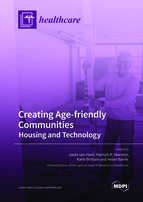Creating Age-friendly Communities: Housing and Technology
A special issue of Healthcare (ISSN 2227-9032).
Deadline for manuscript submissions: closed (15 August 2019) | Viewed by 133526
Special Issue Editors
2. Faculty of Environmental Engineering and Geodesy, Department of Spatial Economy, Wrocław University of Environmental and Life Sciences, 50-375 Wrocław, Poland
Interests: age-friendly cities; urban ageing; technology and housing for older people; gerontechnology; design for dementia; participatory design; architecture for health
Special Issues, Collections and Topics in MDPI journals
Interests: digital games; gerontology; design and gamification; oldest old/centenarians; mobile (Health) apps; active & healthy ageing
Special Issues, Collections and Topics in MDPI journals
Interests: social impact that illness can have on the lives of older people; the physical, social and technological environment pose challenges and opportunities for older people and their wider community
Interests: older people, community connectedness, the built environment and social networks; inter-generational family ties, ageing and migration, age friendly communities, and demographic change in rural and regional Australia
Special Issue Information
Dear Colleagues,
The number of older adults is increasing rapidly, and this demographic shift puts an increased level of stress on worldwide healthcare systems. The vast majority of older adults wish to age in place, and many make use of long-term care services, including homecare, rehabilitation services, and social support. One way to support older people to live the life they wish to live is through the age-friendly cities initiative, a world-wide program to make cities better-tuned to the needs of older citizens. Making cities more age-friendly can be done through dedicated housing facilities, home modifications and adaptations.
With advances in technology, the domain of engineering and design offers a wide range of solutions that support daily function, activities, and participation, facilitates the provision of healthcare, and offers means for leisure to older people. Too often, end-users of architectural and technological solutions are not consulted in the design processes and the implementation of the solutions in practice. Their inclusion in these processes is paramount to the success of the proposed and implemented solutions.
The purpose of this Special Issue is to publish high-quality research papers as well as review articles addressing recent advances in age-friendly cities in relation to housing (including urban planning) and technology, both in the broadest sense of the word. Original, high quality contributions that are not yet published or that are not currently under review by other journals or peer-reviewed conferences are welcomed.
Prof. Dr. Joost van Hoof
Dr. Hannah R. Marston
Prof. Dr. Katie Brittain
Dr. Helen Barrie
Guest Editors
Manuscript Submission Information
Manuscripts should be submitted online at www.mdpi.com by registering and logging in to this website. Once you are registered, click here to go to the submission form. Manuscripts can be submitted until the deadline. All submissions that pass pre-check are peer-reviewed. Accepted papers will be published continuously in the journal (as soon as accepted) and will be listed together on the special issue website. Research articles, review articles as well as short communications are invited. For planned papers, a title and short abstract (about 100 words) can be sent to the Editorial Office for announcement on this website.
Submitted manuscripts should not have been published previously, nor be under consideration for publication elsewhere (except conference proceedings papers). All manuscripts are thoroughly refereed through a single-blind peer-review process. A guide for authors and other relevant information for submission of manuscripts is available on the Instructions for Authors page. Healthcare is an international peer-reviewed open access semimonthly journal published by MDPI.
Please visit the Instructions for Authors page before submitting a manuscript. The Article Processing Charge (APC) for publication in this open access journal is 2700 CHF (Swiss Francs). Submitted papers should be well formatted and use good English. Authors may use MDPI's English editing service prior to publication or during author revisions.
Keywords
- Assistive technologies
- Physical environment/space
- Social Media
- Connected care
- Telehealth and telecare
- Community care
- Wearable devices
- Gamification
- Rural ageing
- Urban ageing
- Intergenerational relationships
- Long-term health conditions
- Social connectedness
- Physical activity







